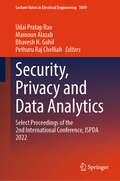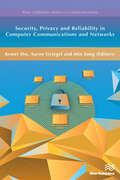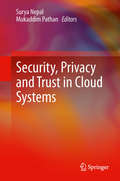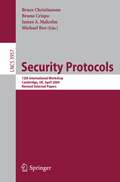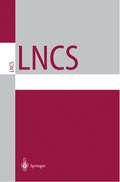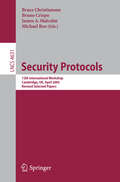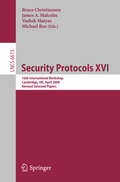- Table View
- List View
Security, Privacy, and Applied Cryptography Engineering: 7th International Conference, SPACE 2017, Goa, India, December 13-17, 2017, Proceedings (Lecture Notes in Computer Science #10662)
by Sk Subidh Ali, Jean-Luc Danger and Thomas EisenbarthThis book constitutes the refereed proceedings of the 7th International Conference on Security, Privacy, and Applied Cryptography Engineering, SPACE 2017, held in Goa, India, in December 2017. The 13 revised full papers presented together with 1 short paper, 7 invited talks, and 4 tutorials were carefully reviewed and selected from 49 initial submissions. This annual event is devoted to various aspects of security, privacy, applied cryptography, and cryptographic engineering. This is indeed a very challenging field, requiring the expertise from diverse domains, ranging from mathematics to solid-state circuit design.
Security, Privacy and Data Analytics: Select Proceedings of the 2nd International Conference, ISPDA 2022 (Lecture Notes in Electrical Engineering #1049)
by Udai Pratap Rao Mamoun Alazab Bhavesh N. Gohil Pethuru Raj ChelliahThis book constitutes refereed proceedings of the International Conference on Security, Privacy and Data Analytics, ISPDA 2022. The volume covers topics, including big data and analytics, cloud security and privacy, data intelligence, hardware security, network security, blockchain technology and distributed ledger, machine learning for security, and many others. The volume includes novel contributions and the latest developments from researchers across industry and academia working in security, privacy, and data analytics from technological and social perspectives. This book will emerge as a valuable reference for researchers, instructors, students, scientists, engineers, managers, and industry practitioners across the globe.
Security, Privacy and Data Analytics: Select Proceedings of ISPDA 2021 (Lecture Notes in Electrical Engineering #848)
by Udai Pratap Rao Sankita J. Patel Pethuru Raj Andrea ViscontiThis book constitutes refereed proceedings of the International Conference on Security, Privacy and Data Analytics, ISPDA 2021. The volume covers a wide range of topics, including big data and analytics, cloud security and privacy, data intelligence, hardware security, network security, blockchain technology and distributed ledger, machine learning for security, and many others. The volume includes novel contributions and the latest developments from researchers across industry and academia working in security, privacy, and data analytics from technological and social perspectives. The book will serve as a valuable reference resource for academics and researchers across the globe.
Security, Privacy, and Digital Forensics in the Cloud
by Lei Chen Hassan Takabi Nhien-An Le-KhacIn a unique and systematic way, this book discusses the security and privacy aspects of the cloud, and the relevant cloud forensics. Cloud computing is an emerging yet revolutionary technology that has been changing the way people live and work. However, with the continuous growth of cloud computing and related services, security and privacy has become a critical issue. Written by some of the top experts in the field, this book specifically discusses security and privacy of the cloud, as well as the digital forensics of cloud data, applications, and services. The first half of the book enables readers to have a comprehensive understanding and background of cloud security, which will help them through the digital investigation guidance and recommendations found in the second half of the book. Part One of Security, Privacy and Digital Forensics in the Cloud covers cloud infrastructure security; confidentiality of data; access control in cloud IaaS; cloud security and privacy management; hacking and countermeasures; risk management and disaster recovery; auditing and compliance; and security as a service (SaaS). Part Two addresses cloud forensics – model, challenges, and approaches; cyberterrorism in the cloud; digital forensic process and model in the cloud; data acquisition; digital evidence management, presentation, and court preparation; analysis of digital evidence; and forensics as a service (FaaS). Thoroughly covers both security and privacy of cloud and digital forensics Contributions by top researchers from the U.S., the European and other countries, and professionals active in the field of information and network security, digital and computer forensics, and cloud and big data Of interest to those focused upon security and implementation, and incident management Logical, well-structured, and organized to facilitate comprehension Security, Privacy and Digital Forensics in the Cloud is an ideal book for advanced undergraduate and master's-level students in information systems, information technology, computer and network forensics, as well as computer science. It can also serve as a good reference book for security professionals, digital forensics practitioners and cloud service providers.
Security, Privacy, and Digital Forensics in the Cloud
by Lei Chen Hassan Takabi Nhien-An Le-KhacIn a unique and systematic way, this book discusses the security and privacy aspects of the cloud, and the relevant cloud forensics. Cloud computing is an emerging yet revolutionary technology that has been changing the way people live and work. However, with the continuous growth of cloud computing and related services, security and privacy has become a critical issue. Written by some of the top experts in the field, this book specifically discusses security and privacy of the cloud, as well as the digital forensics of cloud data, applications, and services. The first half of the book enables readers to have a comprehensive understanding and background of cloud security, which will help them through the digital investigation guidance and recommendations found in the second half of the book. Part One of Security, Privacy and Digital Forensics in the Cloud covers cloud infrastructure security; confidentiality of data; access control in cloud IaaS; cloud security and privacy management; hacking and countermeasures; risk management and disaster recovery; auditing and compliance; and security as a service (SaaS). Part Two addresses cloud forensics – model, challenges, and approaches; cyberterrorism in the cloud; digital forensic process and model in the cloud; data acquisition; digital evidence management, presentation, and court preparation; analysis of digital evidence; and forensics as a service (FaaS). Thoroughly covers both security and privacy of cloud and digital forensics Contributions by top researchers from the U.S., the European and other countries, and professionals active in the field of information and network security, digital and computer forensics, and cloud and big data Of interest to those focused upon security and implementation, and incident management Logical, well-structured, and organized to facilitate comprehension Security, Privacy and Digital Forensics in the Cloud is an ideal book for advanced undergraduate and master's-level students in information systems, information technology, computer and network forensics, as well as computer science. It can also serve as a good reference book for security professionals, digital forensics practitioners and cloud service providers.
Security, Privacy and Reliability in Computer Communications and Networks
by Kewei Sha Aaron Striegel Min SongFuture communication networks aim to build an intelligent and efficient living environment by connecting a variety of heterogeneous networks to fulfill complicated tasks. These communication networks bring significant challenges in building secure and reliable communication networks to address the numerous threat and privacy concerns. New research technologies are essential to preserve privacy, prevent attacks, and achieve the requisite reliability. Security, Privacy and Reliability in Computer Communications and Networks studies and presents recent advances reflecting the state-of-the-art research achievements in novel cryptographic algorithm design, intrusion detection, privacy preserving techniques and reliable routing protocols. Technical topics discussed in the book include: Vulnerabilities and Intrusion DetectionCryptographic Algorithms and EvaluationPrivacyReliable Routing ProtocolsThis book is ideal for personnel in computer communication and networking industries as well as academic staff and collegial, master, Ph.D. students in computer science, computer engineering, cyber security, information insurance and telecommunication systems.
Security, Privacy and Reliability in Computer Communications and Networks
Future communication networks aim to build an intelligent and efficient living environment by connecting a variety of heterogeneous networks to fulfill complicated tasks. These communication networks bring significant challenges in building secure and reliable communication networks to address the numerous threat and privacy concerns. New research technologies are essential to preserve privacy, prevent attacks, and achieve the requisite reliability. Security, Privacy and Reliability in Computer Communications and Networks studies and presents recent advances reflecting the state-of-the-art research achievements in novel cryptographic algorithm design, intrusion detection, privacy preserving techniques and reliable routing protocols. Technical topics discussed in the book include: Vulnerabilities and Intrusion DetectionCryptographic Algorithms and EvaluationPrivacyReliable Routing ProtocolsThis book is ideal for personnel in computer communication and networking industries as well as academic staff and collegial, master, Ph.D. students in computer science, computer engineering, cyber security, information insurance and telecommunication systems.
Security, Privacy and Trust in Cloud Systems
by Surya Nepal Mukaddim PathanThe book compiles technologies for enhancing and provisioning security, privacy and trust in cloud systems based on Quality of Service requirements. It is a timely contribution to a field that is gaining considerable research interest, momentum, and provides a comprehensive coverage of technologies related to cloud security, privacy and trust. In particular, the book includes - Cloud security fundamentals and related technologies to-date, with a comprehensive coverage of evolution, current landscape, and future roadmap. - A smooth organization with introductory, advanced and specialist content, i.e. from basics of security, privacy and trust in cloud systems, to advanced cartographic techniques, case studies covering both social and technological aspects, and advanced platforms. - Case studies written by professionals and/or industrial researchers. - Inclusion of a section on Cloud security and eGovernance tutorial that can be used for knowledge transfer and teaching purpose. - Identification of open research issues to help practitioners and researchers. The book is a timely topic for readers, including practicing engineers and academics, in the domains related to the engineering, science, and art of building networks and networked applications. Specifically, upon reading this book, audiences will perceive the following benefits: 1. Learn the state-of-the-art in research and development on cloud security, privacy and trust. 2. Obtain a future roadmap by learning open research issues. 3. Gather the background knowledge to tackle key problems, whose solutions will enhance the evolution of next-generation secure cloud systems.
Security, Privacy, and Trust in Modern Data Management (Data-Centric Systems and Applications)
by Milan Petkovic Willem JonkerThe vision of ubiquitous computing and ambient intelligence describes a world of technology which is present anywhere, anytime in the form of smart, sensible devices that communicate with each other and provide personalized services. However, open interconnected systems are much more vulnerable to attacks and unauthorized data access. In the context of this threat, this book provides a comprehensive guide to security and privacy and trust in data management.
Security, Privacy and Trust in the IoT Environment
by Zaigham MahmoodThe Internet of Things (IoT) is a network of devices and smart things that provides a pervasive environment in which people can interact with both the cyber and physical worlds. As the number and variety of connected objects continue to grow and the devices themselves become smarter, users’ expectations in terms of adaptive and self-governing digital environments are also on the rise. Although, this connectivity and the resultant smarter living is highly attractive to general public and profitable for the industry, there are also inherent concerns. The most challenging of these refer to the privacy and security of data, user trust of the digital systems, and relevant authentication mechanisms. These aspects call for novel network architectures and middleware platforms based on new communication technologies; as well as the adoption of novel context-aware management approaches and more efficient tools and devices.In this context, this book explores central issues of privacy, security and trust with regard to the IoT environments, as well as technical solutions to help address them. The main topics covered include:• Basic concepts, principles and related technologies• Security/privacy of data, and trust issues• Mechanisms for security, privacy, trust and authentication• Success indicators, performance metrics and future directions.This reference text is aimed at supporting a number of potential audiences, including• Network Specialists, Hardware Engineers and Security Experts • Students, Researchers, Academics and Practitioners.
Security, Privacy and User Interaction (Springerbriefs In Computer Science Ser.)
by Markus JakobssonThis book makes the case that traditional security design does not take the end-user into consideration, and therefore, fails. This book goes on to explain, using a series of examples, how to rethink security solutions to take users into consideration. By understanding the limitations and habits of users – including malicious users, aiming to corrupt the system – this book Illustrates how better security technologies are made possible. Traditional security books focus on one of the following areas: cryptography, security protocols, or existing standards. They rarely consider the end user as part of the security equation, and when they do, it is in passing. This book considers the end user as the most important design consideration, and then shows how to build security and privacy technologies that are both secure and which offer privacy. This reduces the risk for social engineering and, in general, abuse.Advanced-level students interested in software engineering, security and HCI (Human Computer Interaction) will find this book useful as a study guide. Engineers and security practitioners concerned with abuse and fraud will also benefit from the methodologies and techniques in this book.
Security Protocols: 6th International Workshop, Cambridge, UK, April 15-17, 1998, Proceedings (Lecture Notes in Computer Science #1550)
by Bruce Christianson Bruno Crispo William S. Harbison Michael RoeThis book constitutes the thoroughly refereed post-workshop proceedings of the 6th International Workshop on Security Protocols held in Cambridge, UK in April 1998.The 15 revised papers presented as position statements are followed by transcripts of the discussions between the authors and the audience. Also included is a report on the final panel discussion on future directions in security protocols research and developments. Thus the volume reflects the lively interaction at the workshop. The papers are devoted to the interrelations between trust and delegation, exploring the implications and effects of these upon such issues as authorization, security policy, and cryptosystems and component design.
Security Protocols: 11th International Workshop, Cambridge, UK, April 2-4, 2003, Revised Selected Papers (Lecture Notes in Computer Science #3364)
by Bruce Christianson Bruno Crispo James A. Malcolm Michael RoeGreetings. These are the proceedings of the 11th in our series of International Workshops on Security Protocols. Our theme this time was “Where have all the Protocols gone?” Once upon a time security protocols lived mainly in the network and transport layers. Now they increasingly hide in applications, or in specialised hardware. Does this trend lead to better security architectures, or is it an indication that we are addressing the wrong problems? The intention of the workshops is to provide a forum where incompletely workedoutideascanstimulatediscussion,openupnewlinesofinvestigation,and suggestmoreproblems. The positionpaperspublished herehavebeen revisedby the authors in the light of their participation in the workshop. In addition, we publish edited transcripts of some of the discussions, to give our readers access to some of the roads ahead not (yet) taken. We hope that these revised position papers and edited transcripts will give you at least one interesting idea of your own to explore. Please do write and tell us what it was. Our purpose in publishing these proceedings is to produce a conceptual map which will be of enduring interest, rather than to be merely topical. This is perhaps just as well, given the delay in production. This year we moved to new computer-based recording technology, and of course it failed completely.
Security Protocols: 7th International Workshop Cambridge, UK, April 19-21, 1999 Proceedings (Lecture Notes in Computer Science #1796)
by Bruce Christianson Bruno Crispo James A. Malcolm Michael RoeAnother year, another workshop. Here are the proceedings of the seventh Cambridge International Workshop on Security Protocols. All very well, you may think, but can there really still be anything genuinely new to say? Is it not just the same old things a tiny bit better? Well, perhaps surprisingly, this year we discoveredsome radically new things beginning to happen. The reasons in retrospect are not far to seek: advances in technology, changes in the system context, and new types of consumer devices and applications have combined to expose new security requirements. This has led not only to new protocols and models, but also to known protocols being deployedindelicate newways,withpreviousfragilitiesofwatermarkingand- tual authentication, for example, becoming desirable features. At the workshop we identi?ed several of these developments and began to map out some lines of enquiry. This volume brings you a selection of deliberately disputatious position - pers, followed by not-quite-verbatim transcripts of the discussions which they provoked. As always, our purpose in making these proceedings available to you is the hope that they will move your thinking in an unexpected direction. If you ?nd your attention caught by something here, if it makes you pause to re?ect, or to think “why, that is justso wrong”,then good. We’re waiting for your mail.
Security Protocols: 14th International Workshop, Cambridge, UK, March 27-29, 2006, Revised Selected Papers (Lecture Notes in Computer Science #5087)
by Bruce Christianson Bruno Crispo James A. Malcolm Michael RoeWelcome back to the International Security Protocols Workshop. Our theme for this, the 14th workshop in the series, is “Putting the Human Back in the Protocol”. We’ve got into the habit of saying “Of course, Alice and Bob aren’t really people. Alice and Bob are actually programs running in some computers.” But we build computer systems in order to enable people to interact in accordance with certain social protocols. So if we’re serious about system services being end-to-end then, at some level of abstraction, the end points Alice and Bob are humanafterall.Thishascertainconsequences.Weexploresomeoftheminthese proceedings, in the hope that this will encourage you to pursue them further. Is Alice talking to the correct stranger? Our thanks to Sidney Sussex College, Cambridge for the use of their faci- ties, and to the University of Hertfordshire for lending us several of their sta?. Particular thanks once again to Lori Klimaszewska of the University of C- bridge Computing Service for transcribing the audio tapes, and to Virgil Gligor for acting as our advisor.
Security Protocols: 12th International Workshop, Cambridge, UK, April 26-28, 2004. Revised Selected Papers (Lecture Notes in Computer Science #3957)
by Bruce Christianson Bruno Crispo James A. Malcolm Michael RoeThis book constitutes the thoroughly refereed post-proceedings of the 12th International Workshop on Security Protocols, April 2004. The book presents 21 revised full papers presented together with edited transcriptions of some of the discussions following the presentations. Among the topics addressed are authentication, anonymity, verification of cryptographic protocols, mobile ad-hoc network security, denial of service, SPKI, access control, timing attacks, API security, biometrics for security, and others.
Security Protocols: 8th International Workshops Cambridge, UK, April 3-5, 2000 Revised Papers (Lecture Notes in Computer Science #2133)
by Bruce Christianson Bruno Crispo James A. Malcolm Michael RoeThe Cambridge International Workshop on Security Protocols has now run for eight years. Each year we set a theme, focusing upon a speci?c aspect of security protocols, and invite position papers. Anybody is welcome to send us a position paper (yes, you are invited) and we don’t insist they relate to the current theme in an obvious way. In our experience, the emergence of the theme as a unifying threadtakesplaceduringthediscussionsattheworkshopitself.Theonlyground rule is that position papers should formulate an approach to some unresolved issues, rather than being a description of a ?nished piece of work. Whentheparticipantsmeet,wetrytofocusthediscussionsupontheconc- tual issues which emerge. Security protocols link naturally to many other areas of Computer Science, and deep water can be reached very quickly. Afterwards, we invite participants to re-draft their position papers in a way which exposes the emergent issues but leaves open the way to their further development. We also prepare written transcripts of the recorded discussions. These are edited (in some cases very heavily) to illustrate the way in which the di?erent arguments and perspectives have interacted. We publish these proceedings as an invitation to the research community. Although many interesting results ?rst see the light of day in a volume of our proceedings, laying claim to these is not our primary purpose of publication. Rather, we bring our discussions and insights to a wider audience in order to suggest new lines of investigation which the community may fruitfully pursue.
Security Protocols: 10th International Workshop, Cambridge, UK, April 17-19, 2002, Revised Papers (Lecture Notes in Computer Science #2845)
by Bruce Christianson Bruno Crispo James A. Malcolm Michael RoeOnce again we bring you the proceedings of the International Workshop on Security Protocols. It seems hard to believe that we have reached the tenth event in this annual series. This year our theme was “Discerning the Protocol Participants.” Security protocols are usually described in terms of the active participants – Alice c- putes foo and sends it to Bob. However most security protocols also include o?-line participants, which are not synchronously involved in the exchange of messages: a bank may participate on behalf of a customer, and an arbiter may subsequently be asked to interpret the meaning of a run. These silent partners to the protocol have their own security policies, and assumptionsaboutidentity,authorizationandcapabilityneedtobere-examined when the agenda of a hidden participant may change. We hope that the position papers published here, which have been rewritten and rethought in the light of the discussions at the workshop, will be of interest, not just for the speci?c contributions they make but also for the deeper issues which they expose. In order to identify these issues more clearly, we include transcripts for some of the discussions which took place in Cambridge during the workshop. What would you have liked to add? Do let us know.
Security Protocols: 15th International Workshop, Brno, Czech Republic, April 18-20, 2007. Revised Selected Papers (Lecture Notes in Computer Science #5964)
by Bruce Christianson Bruno Crispo James A. Malcolm Michael RoeThis book constitutes the thoroughly refereed post-proceedings of the 15th International Workshop on Security Protocols, held in Brno, Czech Republic, in April 2007. The 15 revised full papers presented together with edited transcriptions of some of the discussions following the presentations have passed through multiple rounds of reviewing, revision, and selection. The topics addressed reflect the question "When is a Protocol Broken?" and how can it degrade gracefully in the face of partially broken assumptions, or how can it work under un(der)specified assumptions.
Security Protocols: 9th International Workshop, Cambridge, UK, April 25-27, 2001 Revised Papers (Lecture Notes in Computer Science #2467)
by Bruce Christianson Bruno Crispo James A. Malcolm Michael RoeHello and welcome. These are the proceedings of the 9th International Workshop on Security Protocols, the ?rst to be held in the new millennium. This year our theme was “mobile computing versus immobile security”. As usual, the insights and challenges which emerged during the workshop are re?ected in the position papers, which appear here in rewritten form. Transcripts are also included of the discussions which took place in C- bridge as the initial versions were presented. These transcripts are intended to provide a perspective on lines of argument which are worth pursuing further. Our desire is that you will join with us in this activity, and that as a result you will, like many of our participants, feel moved to propound something quite di?erent from what you originally planned. Our thanks as always to Prof. Roger Needham, FRS and to Microsoft - search Ltd. (Cambridge) for the use of the meeting room and co?ee machine. Thanks also to Lori Klimaszewska of the University of Cambridge Computing Service for transcribing the audio tapes (and for revealing in “Audrey James” a previously unsuspected double life of a well-known double agent), and to Dr. Mary Buchanan for her assistance in editing the transcripts into a Thucydidean mould. Actually, we are often asked how we go about producing the transcripts, especially upon those occasions when, for various reasons, no audio recording was made. This year we bow to pressure and reveal the details of our methodology in the Afterword.
Security Protocols: 13th International Workshop, Cambridge, UK, April 20-22, 2005, Revised Selected Papers (Lecture Notes in Computer Science #4631)
by Bruce Christianson Bruno Crispo James A. Malcom Michael RoeThis book constitutes the thoroughly refereed post-proceedings of the 13th International Workshop on Security Protocols, held in Cambridge, UK, in April 2005. There are 24 revised full papers presented together with edited transcriptions of some of the discussions following the presentations. Among the topics addressed are authentication, anonymity, cryptographics and biometrics, cryptographic protocols, network security, privacy, SPKI, user-friendliness, and access control.
Security Protocols: 21st International Workshop, Cambridge, UK, March 19-20, 2013, Revised Selected Papers (Lecture Notes in Computer Science #8263)
by Frank Stajano Jonathan Anderson Joseph Bonneau Bruce Christianson James MalcolmThis book constitutes the thoroughly refereed post-workshop proceedings of the 21st International Workshop on Security Protocols, held in Cambridge, UK, in March 2013. The volume contains 14 revised papers with transcripts of the presentation and workshop discussion and an introduction, i.e. 15 contributions in total. The theme of the workshop was "What's Happening on the Other Channel?".
Security Protocols XIX: 19th International Workshop, Cambridge, UK, March 28-30, 2011, Revised Selected Papers (Lecture Notes in Computer Science #7114)
by Bruce Christianson Bruno Crispo James Malcolm Frank StajanoThis book constitutes the thoroughly refereed post-workshop proceedings of the 19th International Workshop on Security Protocols, held in Cambridge, UK, in March 2011. Following the tradition of this workshop series, each paper was revised by the authors to incorporate ideas from the workshop, and is followed in these proceedings by an edited transcription of the presentation and ensuing discussion. The volume contains 17 papers with their transcriptions as well as an introduction, i.e. 35 contributions in total. The theme of the workshop was "Alice doesn't live here anymore".
Security Protocols XVI: 16th International Workshop, Cambridge, UK, April 16-18, 2008. Revised Selected Papers (Lecture Notes in Computer Science #6615)
by James Malcolm Vashek Matyas Michael Roe Bruce ChristiansonThis book constitutes the thoroughly refereed post-proceedings of the 16th International Workshop on Security Protocols, SP 2008, held in Cambridge, UK, in April 2008. The 17 revised full papers presented together with edited transcriptions of some of the discussions following the presentations have gone through multiple rounds of reviewing, revision, and selection. The theme of this workshop was “Remodelling the Attacker” with the intention to tell the students at the start of a security course that it is very important to model the attacker, but like most advice to the young, this is an oversimplification. Shouldn’t the attacker’s capability be an output of the design process as well as an input? The papers and discussions in this volume examine the theme from the standpoint of various different applications and adversaries.
Security Protocols XVII: 17th International Workshop, Cambridge, UK, April 1-3, 2009. Revised Selected Papers (Lecture Notes in Computer Science #7028)
by Bruce Christianson James A. Malcolm Vashek Matyás Michael RoeThis book constitutes the thoroughly refereed post-proceedings of the 17th International Workshop on Security Protocols, SP 2009, held in Cambridge, UK, in April 2009. The 17 revised full papers presented together with edited transcriptions of some of the discussions following the presentations have gone through multiple rounds of reviewing, revision, and selection. The theme of this workshop was "Brief Encounters". In the old days, security protocols were typically run first as preliminaries to, and later to maintain, relatively stable continuing relationships between relatively unchanging individual entities. Pervasive computing, e-bay and second life have shifted the ground: we now frequently desire a secure commitment to a particular community of entities, but relatively transient relationships with individual members of it, and we are often more interested in validating attributes than identity. The papers and discussions in this volume examine the theme from the standpoint of various different applications and adversaries.

